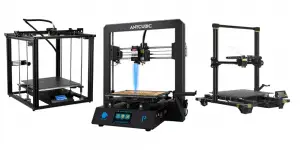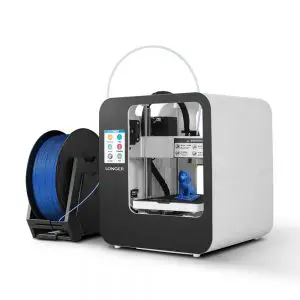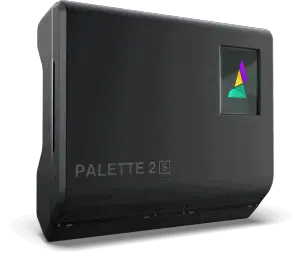Today’s offering is the FlashForge Finder 3D printer, manufactured by FlashForge. The Finder is a starter unit, designed for quick startup and consistent low-volume printing. It is also portable, weighing in at just 27 pounds. The frame is open, so users can see layers being added as their creations come to life.
FlashForge Finder Technical Specifications
- Max print size: 140 x 140 x 140 mm, or 5.5 x 5.5 x 5.5 inches
- File format: st; obj
- Filament type: PLA, in any color
- Filament diameter: 0.4 mm
- Printer speed: up to 40 mm/sec in Hyperspeed; variable speed settings
- Extruder type: single, no upgrades
- Extruder diameter: 1.75 mm
- Heated printer plate?: yes
Design and Features
This is an open frame design portable wireless printer for those who are just learning the art of 3D printing. Its price is on a par with other similar models we have seen. It also has a few more robust features than others we have seen with the same market goals. Tabletop printers, like the FlashForge Finder 3D, are great for kids and for places like rec center or libraries. Situations where a skilled person can show beginners the rules, then walk them through their first projects.
The FlashForge isn’t suited to larger public school classrooms, though. That’s only because it does not have the volume to keep up with that much demand. If you want a 3D machine for an institutional setting, there are other models from FlashForge and others that will suit you.
The frame is a cube design with rounded plastic edges. You can see inside the printer the whole time it works, including watching the single extruder spray layer after layer onto the build plate. Though there’s no way to enclose the workspace, safety features are such that no curious hands will find their way onto the hot extruders or the print plate. You will still want to supervise kids, of course, when they use this printer.
The screen is an IPS color touchscreen, located near the top front of the printer. This is where you pull files to send for building, as well as set the print parameters. You also change filament using the screen, and it will alert you when filament needs replacing. One menu lets you preheat the build plate, like a conventional oven. You can level the build plate manually or automatically, and connect to wireless, all from the small but richly featured touch screen.
There are even some advanced settings, like turning on the servo or adjusting the minuscule distance between the extruder tip and the build plate. This is unusual for a compact starter model, and it means the unit will grow with you as your 3D printing skills get stronger.
Printing
Abstract models printed by 3d printer close-up. Bright colorful objects printed on a 3d printer on a white table. Progressive modern additive technology. Concept of 4.0 industrial revolution. Print quality got high marks in the aggregate of reviews we looked at. These included reviews from tech and gear websites, as well as consumer reviews. Mishaps, jams, and misprints were uncommon, but not unheard of. FlashForge includes a glue stick and bed tape, to help keep the work attached to the print plate and to keep the plate in place during extrusion.
You may need to fight with settings and unforeseen glitches, to get the printer to print for the first time. This is an annoyance and may be severe enough for you to pass. It definitely means the Finder is not suited for a commercial maker, studio, or print farm applications. You are also limited to PLA filament, which further locks you into not-terrible-but-still-average print quality. There is also no option to use a corn-based filament, which has less of an environmental impact and may be desirable to some users. The limited filament may be a plus to novices because the array of filament choices can be overwhelming at first glance.
The filament is easy and straightforward to attach to the spool and place inside the printer. The maximum spool size is .06 kilograms. If you want to upgrade later, there are external spool holders that will increase capacity. Since the factory spool assembly is inside the printer, it is protected from environmental damage and will not degrade as quickly.
Print setup is easy and fast, even for first-timers. You can let the system decide for you, using common settings, or override that feature and program it yourself. FlashForge is committed to education, so there are galleries of customer creations as well as blueprints for more builds on the website. We will talk about FlashForge’s customer service reputation a little further down.
Finder 3D Printer Packaging and Assembly
In this section, we’ll cover what comes in the box when you purchase the FlashForge Finder.
Because its inner workings are delicate, the Finder is wrapped in plastic, cardboard, styrofoam, and tape. The manual walks you through exactly how to unbox without causing damage. Even if you are a veteran of setting up new electronic devices, we strongly suggest you use the directions. There may be pieces of tape inside the printer that will keep it from working if not removed.
Once open, you will find:
- FlashForge Finder unit
- Roll of PLA filament
- USB cable
- AC power cord
- Filament guide tube (this gets installed between the filament end and the extruder inlet)
- Quick start guide
- USB drive
- 3 Allen wrenches, a screwdriver (needed for assembly)
- A glue stick
The glue stick is used to help the initial build material (extruded filament) stick to the print bed. Without an adhesive, you may get warping, curling, separation, and misprints. If you have never used a 3D printer before, be sure to follow directions and always use the glue or tape provided with purchase. More seasoned users will find they can use their judgment, as an adhesive is not always necessary for every build.
While unboxing and initial assembly are a multi-step process, they do not appear difficult. The manual uses both photographs and drawings to help you. Remember that most of the non-attached components, including the quick start book, will be inside the printer’s body. Make sure they are all out before you begin assembly.
Support
The Finder includes a warranty from FlashForge, good for 180 days. You can extend this to a full year by paying extra. If we have a gripe, it’s that the extended warranty is overpriced. All warranties cover parts and labor, although misuse of the printer or filament will void the warranty.
If you have a problem severe enough to need outside help, FlashForge offers several contact methods. First of all, an online knowledge base is continually updated with solutions to common problems. The link to the online site is in the back of the user’s manual. However, when we clicked that link, it took us to a Chinese language version of the regular splash page. We had to translate and then search for what we needed.
Headquarters are in China, and customer service is open from 8 AM to 5 PM U.S. Pacific time, every day except Sunday. To call support, you need the serial number which appears on the back of the printer. No information was available about shipping a defective printer to China. We would hope this is not the case, but FlashForge provides no direction that we were able to find. We assume a third party agent could come to your home or school for warranty work.
FlashForge Finder Pros and Cons
Pros:
- Easy setup for beginners
- Low price, but not cheaply made
- Lightweight, portable, and wireless
- Directions are clear and easy to understand
- Can add an external print spool later
- Heated surfaces are protected even with the open design
Cons:
- Centralized controls from a responsive color touchscreen
- Only PLA filament available to use
- More than one reviewer noted repeated temporary glitches
Verdict
We can recommend the FlashForge Finder wireless 3D printer to most beginner and low volume makers, with a few qualifiers.
Though there are some advanced features, like the touchscreen, they may not put the Finder so far above other comparable portables that the extra cost is justified. You will have to comparison shop and decide if you are OK with spending the extra money to have a few more features. Build quality, speed, and consistency will not be wildly different between portable units.
While FlashForge provides plenty of free help, like 3D project blueprints and a knowledge forum, we weren’t able to find the forum when we needed it. It isn’t clear how fast and responsive FlashForge will be in responding to warranty requests.
However, this is still an ideal extra printer or gift for someone just starting out. Setup is easy, with all the filament and other tools included. Print speed is adequate, and the extruder meets industry standards. Build quality is good, and mishaps are infrequent and easy to correct with practice. If you are interested in some of the high-end features but do not want a full-priced or full-fledged maker space printer, the FlashForgeFinder 3D printer may be your best bet.
Last update on 2025-06-06 / Affiliate links / Images from Amazon Product Advertising API







